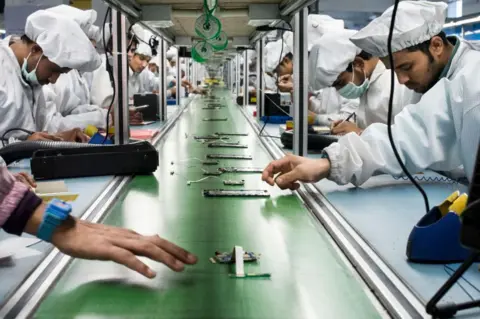 Getty Images
Getty ImagesOn Tuesday, Indian Prime Minister Narendra Modi's coalition government will present its first federal budget after a narrow election victory.
A weakened Mr. Modi, reliant on coalition partners for the first time, is widely expected to reorient his spending policies while maintaining fiscal caution.
Analysts say the new government may need to focus more on the rural majority, who have not benefited as much from the country's fast-growing GDP as the rich.
The fact that this is Mr. Modi's third term will preoccupy him with the idea of leaving a lasting legacy and could “tempt” him to do something for the economic prosperity of the masses, says Rathin Roy, a former member of the Economic Advisory Council of the Prime Minister.
“It is the one area in which his legacy shows that he has conspicuously failed in the past.”
In the decade he has been in power, Mr. Modi has poured billions of dollars into state-funded infrastructure, building sea bridges and highways. He has also made tax cuts for large corporations and introduced subsidy programs to incentivize export-oriented manufacturing.
India's shaky macroeconomy has stabilized and stock markets have soared.
But inequality and rural distress have also increased.
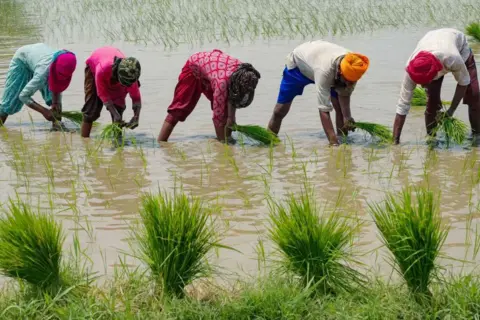 AFP
AFPBMW vehicles posted their highest sales ever in the first half of this year, although overall consumption growth was the lowest in two decades.
Wages have stagnated, household savings have declined and well-paying jobs remain out of reach for most Indians.
India's regional imbalances are also stark. According to Mr Roy, much of the country lives in the north and east of India, where per capita income is lower than Nepal and health, mortality and life expectancy worse than Burkina Faso.
Nine out of ten economists now say that chronic unemployment is the biggest challenge for Modi 3.0. A post-election poll shows that seven in 10 Indians support taxing the super-rich and eight in 10 economists believe growth has not been inclusive.
As we travel through the agricultural heartland of northern India, the fate of the rural majority stands out in sharp contrast to that of the people in the cities.
Muzaffarnagar in the northern state of Uttar Pradesh is barely a few hours from the Indian capital Delhi. Aside from the state-of-the-art highway that runs through the vast open fields, it feels like a region that has been largely ignored by the country's brilliant economic boom.
Sushil Pal's family has been farming the plains of Behra Asa village for generations. It's hard work that's hardly worth it, he told the BBC.
Mr Pal did not vote for Mr Modi's party this time, despite supporting it in the previous two elections. The Prime Minister's promise to double farm incomes remained just that – a promise.
“My income has gone down. The cost of inputs and labor has increased, but not my crop,” Mr Pal said. “They only slightly increased sugarcane procurement prices before the elections.
“All the money I earn goes towards paying school fees for my sons. One is an engineer but hasn’t had a job for two years,” he said.
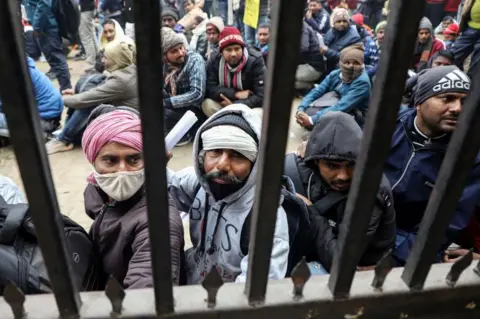 AFP
AFPA neighboring export-focused furniture workshop has seen sales fall 80% over the past five years as global orders dried up following a post-Covid sales surge.
Rajneesh Tyagi, the owner, said he would have liked to sell locally to ease the lull abroad, but ongoing hardship in the countryside means there is no demand for his products.
“The agricultural economy is in decline and the biggest problem with growing local demand is high farmer debt and unemployment,” he added. “They don’t have the capacity to buy anything.”
Mr. Tyagi's company represents a wide range of micro-enterprises that form the backbone of the Indian economy. India Ratings, a ratings agency, estimates that 6.3 million businesses closed between 2015 and 2023, costing 16 million informal jobs.
In contrast, profits reported by India's 5,000 listed companies rose sharply by 187% between 2018 and 2023, partly due to tax cuts, according to commentator Vivek Kaul.
The biggest challenges for Mr. Modi, as he enters his third term, will be bridging the gaping gaps between the formal and informal parts of the economy and bringing prosperity to India's villages.
There could be a “tilt” toward welfare in his first post-election budget, but not necessarily a move away from more investment in big infrastructure projects, economists at Goldman Sachs said in a note.
A higher-than-expected central bank dividend transfer (0.3% of GDP) will allow the government to boost social spending and maintain capital spending, with a focus on the rural economy and job creation, the Wall Street bank said .
Even those who manage money for some of India's richest agree with this view.
Rajesh Saluja, CEO and managing director of ASK Private Wealth, says poverty alleviation is most likely to be on the government's budget agenda and that this can be done “without messing up the financial equation” given the strong revenue and tax collections.
 Getty Images
Getty ImagesBut economists warn that more spending is a poor substitute for real reform-oriented development. About 800 million Indians already live on free grains and some countries spend almost 10% of their income on welfare schemes.
The budget must set out a vision of how the government will put millions into the workforce and create earning opportunities.
“The smaller footprint of the unorganized sector has an impact on job creation. Therefore, in the meantime, a sensible policy mix needs to be adopted that allows co-existence of both the formal and informal sectors,” said Sunil Kumar Sinha, chief economist at India Ratings.
India should also incentivize low-end, labor-intensive production in sectors such as textiles and agri-food processing to meet its massive domestic demand, says Roy.
Economists at India's largest bank SBI have suggested extending the manufacturing-related incentives Modi has offered to export-oriented sectors to small businesses.
“When we think of manufacturing, we think of noble people. We think about supercomputers. We are thinking about getting Apple to come here and make a few iPhones,” Mr Roy said.
“These are not things that 70% of the Indian population consumes. We should produce in India what 70% of the Indian population wants to consume. If I can make shirts for 200 rupees ($2.4, £1.8) in this country and that import demand doesn’t go to Bangladesh and Vietnam, that will boost production.”

“Pop culture scholar. Subtly charming beer specialist. Reader. Student. Devoted music advocate.”

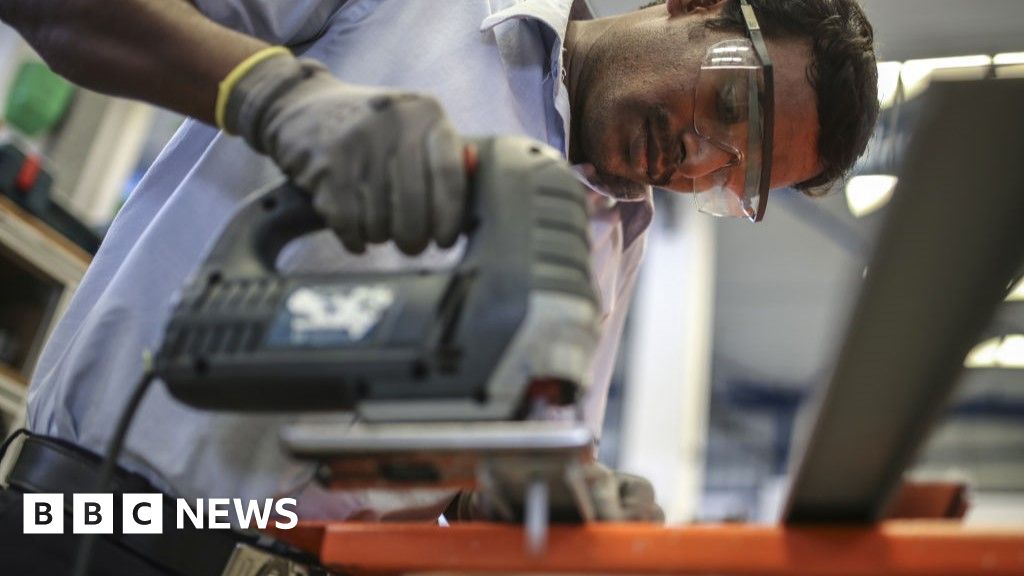

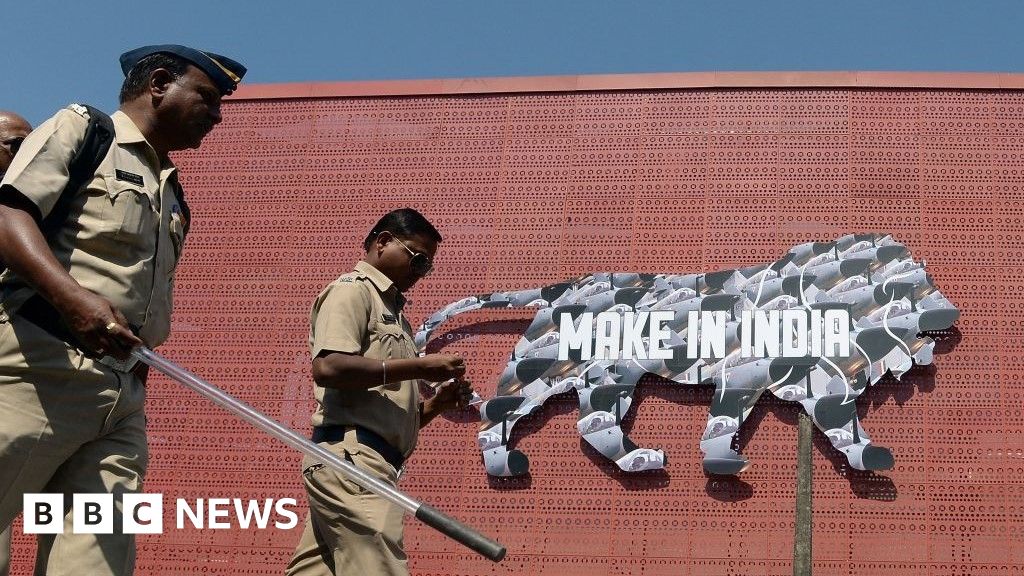
.jpg?w=1200&auto=format%2Ccompress&ogImage=true)



